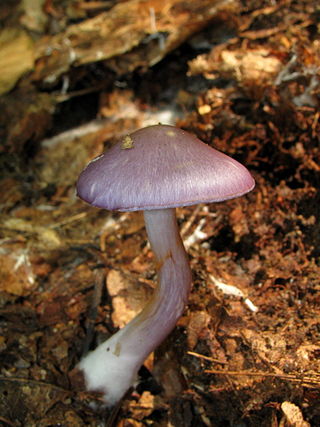
The shiitake is an edible mushroom native to East Asia, which is cultivated and consumed around the globe. It is considered a medicinal mushroom in some forms of traditional medicine.

Pleurotus is a genus of gilled mushrooms which includes one of the most widely eaten mushrooms, P. ostreatus. Species of Pleurotus may be called oyster, abalone, or tree mushrooms, and are some of the most commonly cultivated edible mushrooms in the world. Pleurotus fungi have also been used in mycoremediation of pollutants, such as petroleum and polycyclic aromatic hydrocarbons.

Omphalotus nidiformis, or ghost fungus, is a gilled basidiomycete mushroom most notable for its bioluminescent properties. It is known to be found primarily in southern Australia and Tasmania, but was reported from India in 2012 and 2018. The fan or funnel shaped fruit bodies are up to 30 cm (12 in) across, with cream-coloured caps overlain with shades of orange, brown, purple, or bluish-black. The white or cream gills run down the length of the stipe, which is up to 8 cm (3 in) long and tapers in thickness to the base. The fungus is both saprotrophic and parasitic, and its fruit bodies are generally found growing in overlapping clusters on a wide variety of dead or dying trees.

Irpex lacteus is a common crust fungus distributed throughout temperate areas of the world. It is the type of the genus Irpex. Irpex lacteus is considered a polypore, but depending on growth conditions it can also produce a hydnoid hymenophore. Due to this variability and abundance of the species it has been described as a new species to science numerous times and subsequently has an extensive synonymy. The complete genome sequence of Irpex lacteus was reported in 2017.

Puccinia recondita is a fungus species and plant pathogen belonging to the order of Pucciniales and family Pucciniaceae.

Pleurotus dryinus, commonly known as the veiled oyster mushroom, is a species of fungus in the family Pleurotaceae. It grows on dead wood and is also a weak pathogen; infecting especially broad-leaved trees.

Lentinus is a genus of fungi in the family Polyporaceae. The genus is widely distributed, with many species found in subtropical regions.

Scutellinia olivascens is a species of apothecial fungus belonging to the family Pyronemataceae. This European fungus forms clusters of orange discs up to 1.5 cm in diameter on soil or rotting wood in summer and autumn. It is very similar to the common species Scutellinia umbrorum and can only be reliably identified by microscopic features.

Boletus curtisii is a species of fungus in the family Boletaceae. It produces small- to medium-sized fruit bodies (mushrooms) with a convex cap up to 9.5 cm (3.7 in) wide atop a slender stem that can reach a length of 12 cm (4.7 in). In young specimens, the cap and stem are bright golden yellow, although the color dulls to brownish when old. Both the stem and cap are slimy or sticky when young. On the underside of the cap are small circular to angular pores. The mushroom is edible, but not appealing. It is found in eastern and southern North America, where it grows in a mycorrhizal association with hardwood and conifer trees. Once classified as a species of Pulveroboletus, the yellow color of B. curtisii is a result of pigments chemically distinct from those responsible for the yellow coloring of Pulveroboletus.

Cortinarius iodes, commonly known as the spotted cort or the viscid violet cort, is a species of agaric fungus in the family Cortinariaceae. The fruit bodies have small, slimy, purple caps up to 6 cm (2.4 in) in diameter that develop yellowish spots and streaks in maturity. The gill color changes from violet to rusty or grayish brown as the mushroom matures. The species range includes eastern North America, Central America, northern South America, and northern Asia, where it grows on the ground in a mycorrhizal association with deciduous trees. The mushroom is not recommended for consumption. Cortinarius iodeoides, one of several potential lookalike species, can be distinguished from C. iodes by its bitter-tasting cap cuticle.

Termitomyces microcarpus is a species of agaric fungus in the family Lyophyllaceae. An edible species, it is found in Africa and Asia, where it grows in groups or clusters in deciduous forests near the roots of bamboo stumps associated with termite nests.

Cytidia salicina commonly known as Scarlet Splash is a species of Fungus that is found growing on willows and other deciduous woody plants in Europe. The spores are 12-18x4-5 um.

Lentinellus micheneri is a species of wood-inhabiting fungus in the family Auriscalpiaceae. It was first described in 1853 by mycologist Miles Berkeley and Moses Ashley Curtis as Lentinus micheneri. David Pegler transferred it to the genus Lentinellus in 1983. Like all species in its genus, it is inedible.

Cocculus orbiculatus, the queen coralbead, is a species of woody vines. It is found from India east to Java.
Corydalis elegans is a species of plant in the family Papaveraceae. It is found in India, China and the West Himalayas.

Cookeina tricholoma, also known by its common name bristly tropical cup, is a species of fungus from the genus Cookeina.
Leucocoprinus zeylanicus is a species of mushroom producing fungus in the family Agaricaceae.
Pterulicium gracile is a species of mushroom producing fungus in the family Pterulaceae.

Pleurotus albidus is a species of edible fungus in the family Pleurotaceae. Found in Caribbean, Central America and South America, it was described as new to science by Miles Joseph Berkeley, and given its current name by David Norman Pegler in 1983. It grows on trees such as Salix humboldtiana, other willows, Populus and Araucaria angustifolia, and can be cultivated by humans. Phylogenetic research has shown that while it belongs to P. ostreatus clade, it forms its own intersterility group.
















